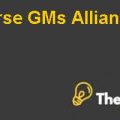Introduction
The case is based on three hypothetical companies, namely Harris, Urban, and Maya. Each company in the portfolio is in a different industry such as Harris is a producer of packaged food products while Urban develops educational products, and Maya is a biotech company that operates in the health care industry. By investment in the different company portfolio will be build and investment will be diversified.
Issue
The issue is that all the investment is made in single stock than the investment is at stake of potential risk that its value will decline. If the same investment is made in three different stocks in different industries and different sectors then risk is minimized through diversification. The benefits of diversification are accessed via mean, standard deviation and co-relation and weight of the invested amount in each company.
Analysis
Monthly return of security included from year 1991 to year 2009 for better analysis of the security movements and monthly returns.
The average mean return of stock one which is Haris is calculated to be 0.58 in 240 months while the Urban mean return is calculated as 0.83 and standard deviation of 8.24. The concept of standard deviation measures the amount of dispersion from the mean value. Standard deviation also reflects the risk that can be quantified through the standard deviation.
Individual securities have more risk that can be minimized using the portfolio suppose stock one standard deviation is 5.80 while stock two standard deviation is 8.24 and stock three standard deviation is 12.60. The Higher return brings higher risk. Suppose all investment is made in one stock such as a stock three which yield a high return, but it also have a higher risk among all in stock.
If equal investment is made in all three stocks than risk and return would be as follows,
| Stock | Allocation | Mean Return | Risk |
| Stock 1 | 33.33% | 0.1933 | 1.933 |
| Stock 2 | 33.33% | 0.2766 | 2.746 |
| Stock 3 | 33.33% | .03599 | 4.199 |
| Total | 100% | 0.8298 | 8.876 |
Through diversification of the equally balanced portfolio, the mean return is summed up to 0.8298% while the risk is reduced to 8.876 which individually have high risk.
Two asset portfolios with a correlation of between stock 1 and stock 2 are 0.30. The correlation can be interpreted as dependency between two stocks. Positive 0.30 means that the shares will move together by the percentage of 30%. In portfolio management terms, if the correlation is negative, then diversification benefit will increase. (Cohen)
Through analysis of portfolio, mix indicates that at what percentage of investment should be made to maximize return and minimize risk. Following graph depict the two asset portfolio
In this graph it is depicted that risk is minimized at zone of 0.55 of return and standard deviation of approx 6.5, if an investor goes for higher return than risk is increased in order to maximize the return.
If the investment is made in three assets rather than two than risk is further diversified due to over all diversification benefit and correlation among the stocks. The following graph depicts the whole scenario,
The risk is minimized at the region of between 0.50 to 0.75 returns and between the standard deviation of 5 to 7.5. The overall risk is minimized when there is an addition of more stocks.
If there is an addition of bond in the portfolio then it should be noted that the bond is considered as risk-free, and there is no standard deviation. If any of the investment is made in bond, it will significantly reduce risk and so the standard deviation as well. (Markowitz)
Portfolio Selection and Capital Asset Pricing Model Case Solution
The concept of SML that represent the capital asset pricing model (CAPM) which display the expected rate of return. CAPM asset. CAPM is a model that describes the relationship between risks and expected the return that is used in pricing the risk assets.
If an index is used as an allowable investment than average returns and risk will equal to 1. Which means that the return will be equal to same as index? The net impact will be total portfolio will head towards a positive correlation that will further reduce the benefit of diversification (Berk, 2012)
Recommendation
It is highly recommended to the investor that he should make IPS first then should invest in certain shares. If he is young and has a good salary and can afford risk then he can invest the whole of his investment in stock three, which is riskier and yield higher returns. If investor is retiring and needs a constant amount of income then he should invest in less riskier stock........................
This is just a sample partial case solution. Please place the order on the website to order your own originally done case solution













